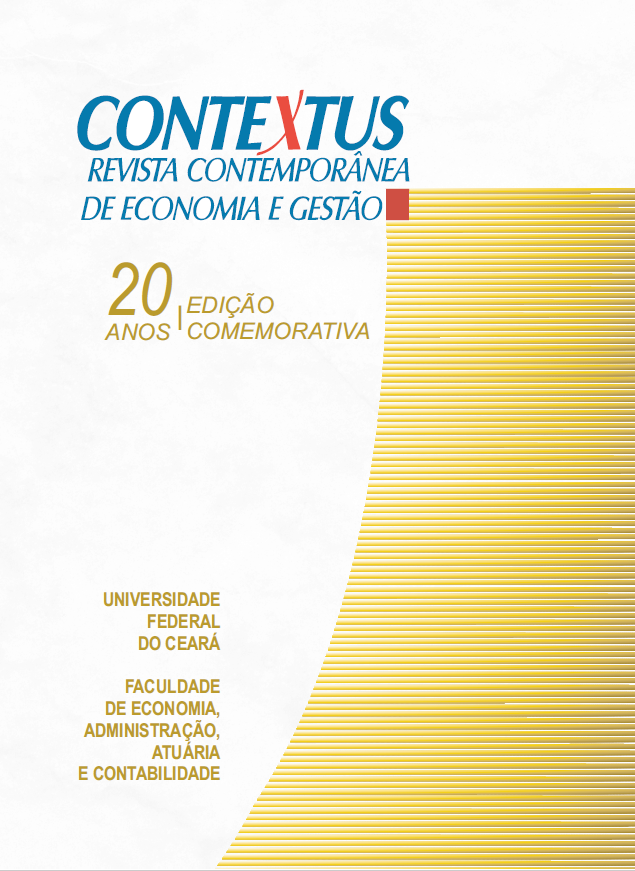Teletrabalho: Uma revisão integrativa da literatura internacional
DOI:
https://doi.org/10.19094/contextus.2023.88624Palavras-chave:
teletrabalho, trabalho em casa, formas flexíveis de trabalho, revisão integrativa, produção científicaResumo
Objetivou-se analisar a produção científica disponível em bases de dados internacionais sobre o teletrabalho, com o intuito de verificar o volume da produção e identificar o foco de estudo dos artigos, por meio da revisão integrativa. A produção científica é crescente, com grande quantidade de artigos de revisão (12). Em relação aos artigos empíricos, com abordagem predominantemente quantitativa, nota-se a baixa publicação em organizações públicas. O foco dos estudos está na busca de impactos causados pela implementação do teletrabalho ao trabalhador e à organização. Identifica-se que há poucos estudos de cunho longitudinal e poucos combinando os diversos atores envolvidos no teletrabalho, principalmente em relação às equipes de trabalho.
Referências
Abdullah, H., & Ismail, N. (2012). Quality of work and life balance in teleworking. International Business Management, 6(2), 119-130. https://doi.org/10.3923/ibm.2012.119.130
Aderaldo, I. L., Aderaldo, C. V. L., & Lima, A. C. (2017). Aspectos críticos do teletrabalho em uma companhia multinacional. Cadernos EBAPE.BR, 15(3), 511-533. https://doi.org/10.1590/1679-395160287
Aguilera, A. et al. (2016). Home-based telework in France: Characteristics, barriers and perspectives. Transportation Research Part A: Policy and Practice, 92, 1-11. https://doi.org/10.1016/j.tra.2016.06.021
Ansong, E., & Boateng, R. (2018). Organisational adoption of telecommuting: Evidence from a developing country. The Electronic Journal of Information Systems in Developing Countries, 84(1), e12008. https://doi.org/10.1002/isd2.12008
Araújo, C. A. (2006). Bibliometria: Evolução histórica e questões atuais. Em Questão, 12(1), 11-32. http://hdl.handle.net/20.500.11959/brapci/10124
Bailey, D. E., & Kurland, N. B. (2002). A review of telework research: Findings, new directions, and lessons for the study of modern work. Journal of Organizational Behavior: The International Journal of Industrial, Occupational and Organizational Psychology and Behavior, 23(4), 383-400. https://doi.org/10.1002/job.144
Bayrak, T. (2012). IT support services for telecommuting workforce. Telematics and informatics, 29(3), 286-293. https://doi.org/10.1016/j.tele.2011.10.002
Bélanger, F. (1999). Workers’ propensity to telecommute: An empirical study. Information & Management, 35(3), 139-153. https://doi.org/10.1016/S0378-7206(98)00091-3
Bélanger, F., Watson-Manheim, M. B., & Swan, B. R. (2013). A multi-level socio-technical systems telecommuting framework. Behaviour & Information Technology, 32(12), 1257-1279. https://doi.org/10.1080/0144929X.2012.705894
Botelho, L. L. R., Cunha, C. C. D. A., & Macedo, M. (2011). O método da revisão integrativa nos estudos organizacionais. Gestão e Sociedade, 5(11), 121-36.
Campbell, J., & Heales, J. (2016). Factor structure of individual consequences for teleworking professionals. Australasian Journal of Information Systems, 20. https://doi.org/10.3127/ajis.v20i0.906
Coenen, M., & Kok, R. A. W. (2014). Workplace flexibility and new product development performance: The role of telework and flexible work schedules. European Management Journal, 32(4), 564-576. https://doi.org/10.1016/j.emj.2013.12.003
Collins, A. M., Hislop, D., & Cartwright, S. (2016). Social support in the workplace between teleworkers, office‐based colleagues and supervisors. New Technology, Work and Employment, 31(2), 161-175. https://doi.org/10.1111/ntwe.12065
Contreras, O. E., & Rozo R. I. (2015). Teleworking and business sustainability. A reflection from the Human Resource Management in Colombia. Suma de Negócios, 6(13), 74-83. https://doi.org/10.1016/j.sumneg.2015.08.006
Cooke, G., Chowhan, & J., Cooper, T. (2014). Dialing it in: A missed opportunity regarding the strategic use of telework? Industrial Relations, 69(3), 550-574. https://doi.org/10.7202/1026758ar
Cordeiro, A. M., Oliveira, G. M. D., Rentería, J. M., & Guimarães, C. A. (2007). Revisão sistemática: Uma revisão narrativa. Rev. Col. Bras. Cir., 34(6), 428-431. https://doi.org/10.1590/S0100-69912007000600012
Costa, I. S. A. (2007). Teletrabalho: Subjugação e construção de subjetividades. Revista de Administração Pública, 41(1), 105-124. https://doi.org/10.1590/S0034-76122007000100007
Dutcher, E. G. (2012). The effects of telecommuting on productivity: An experimental examination. The role of dull and creative tasks. Journal of Economic Behavior & Organization, 84(1), 355-363. https://doi.org/10.1016/j.jebo.2012.04.009
Duxbury, L., & Neufeld, D. (1999). An empirical evaluation of the impacts of telecommuting on intra-organizational communication. Journal of Engineering and Technology Management, 16(1), 1-28.https://doi.org/10.1016/S0923-4748(98)00026-5
Feldman, D. C., & Gainey, T. W. (1997). Patterns of telecommuting and their consequences: Framing the research agenda. Human Resource Management Review, 7(4), 369-388. https://doi.org/10.1016/S1053-4822(97)90025-5
Frolick, M. N., Wilkes, R. B., & Urwiler, R. (1993). Telecommuting as a workplace alternative: An identification of significant factors in American firms’ determination of work-at-home policies. The Journal of Strategic Information Systems, 2(3), 206-220. https://doi.org/10.1016/0963-8687(93)90028-9
Golden, T. D. (2006). Avoiding depletion in virtual work: Telework and the intervening impact of work exhaustion on commitment and turnover intentions. Journal of Vocational Behavior, 69(1), 176-187.https://doi.org/10.1016/j.jvb.2006.02.003
Groen, B. A. C. et al. (2018). Managing flexible work arrangements: Teleworking and output controls. European Management Journal, 36(6), 727-735. https://doi.org/10.1016/j.emj.2018.01.007
Haddon, L., & Brynin, M. (2005). The character of telework and the characteristics of teleworkers. New Technology, Work and Employment, 20(1), 34-46.https://doi.org/10.1111/j.1468-005X.2005.00142.x
Hau, F., & Todescat, M. (2018). Teleworking in the perception of teleworkers and their managers: Advantages and disadvantages in a case study. Navus - Revista de Gestão e Tecnologia, 8(3), 37-52.
Hazan, B. F., & Morato, A. D. P. (2018). Teleworking in Brazilian law: grounds, perspectives and changes promoted by labor reform. Lex Humana, 10(1), 1-24.
Hidalgo, A., & Albors, J. (2008). Innovation management techniques and tools: A review from theory and practice. R&D Management, 38(2), 113-127. https://doi.org/10.1111/j.1467-9310.2008.00503.x
Hill, E. J., Ferris, M., & Märtinson, V. (2003). Does it matter where you work? A comparison of how three work venues (traditional office, virtual office, and home office) influence aspects of work and personal/family life. Journal of Vocational Behavior, 63(2), 220-241. https://doi.org/10.1016/S0001-8791(03)00042-3
Hunton, J. E., & Norman, C. S. (2010). The impact of alternative telework arrangements on organizational commitment: insights from a longitudinal field experiment (retracted). Journal of Information Systems, 24(1), 67-90. https://doi.org/10.2308/jis.2010.24.1.67
Illegems, V., & Verbeke, A. (2004). Telework: What does it mean for management? Long Range Planning, 37(4), 319-334. https://doi.org/10.1016/j.lrp.2004.03.004
Illegems, V., Verbeke, A., & S’Jegers, R. (2001). The organizational context of teleworking implementation. Technological forecasting and social change, 68(3), 275-291. https://doi.org/10.1016/S0040-1625(00)00105-0
Katz, A. I. (1987). The management, control, and evaluation of a telecommuting project: A case study. Information & Management, 13(4), 179-190. https://doi.org/10.1016/0378-7206(87)90055-3
Kossek, E. E., Lautsch, B. A., & Eaton, S. C. (2006). Telecommuting, control, and boundary management: Correlates of policy use and practice, job control, and work–family effectiveness. Journal of Vocational Behavior, 68(2), 347-367. https://doi.org/10.1016/j.jvb.2005.07.002
Kugelmass, J. (1996). Teletrabalho: Novas oportunidades para o trabalho flexível. São Paulo: Atlas.Kurland, N. B., & Cooper, C. D. (2002). Manager control and employee isolation in telecommuting environments. The Journal of High Technology Management Research, 13(1), 107- 126.https://doi.org/10.1016/S1047-8310(01)00051-7
Lee, H., Shin, B., & Higa, K. (2007). Telework vs. central work: A comparative view of knowledge accessibility. Decision Support Systems, 43(3), 687-700.https://doi.org/10.1016/j.dss.2006.11.007
Maruyama, T., Hopkinson, P. G., & James, P. W.(2009). A multivariate analysis of work–life balance outcomes from a large‐scale telework programme. New Technology, Work and Employment, 24(1), 76-88. https://doi.org/10.1111/j.1468-05X.2008.00219.x
Mokhtarian, P. L., & Salomon, I. (1997). Modeling the desire to telecommute: The importance of attitudinal factors in behavioral models. Transportation Research Part A: Policy and Practice, 31(1), 35-50.http://www.uctc.net/papers/284.pdf
Neirotti, P., Paolucci, E., & Raguseo, E. (2012). Telework configurations and labour productivity: some stylized facts. International Journal of Engineering Business Management, 4, 4-5. https://doi.org/10.5772/51641
Nilles, J. M. (1988). Traffic reduction by telecommuting: A status review and selected bibliography. Transportation Research Part A: General, 22(4), 301-317.https://doi.org/10.1016/0191-2607(88)90008-8
Pérez, M. P., Sánchez, A. M., & Carnicer, M. P. L. (2002). Benefits and barriers of telework: Perception differences of human resources managers according to company’s operations strategy. Technovation, 22(12) 775-783.https://doi.org/10.1016/S0166-4972(01)00069-4
Peters, P., Tijdens, K. G., & Wetzels, C. (2004). Employees’ opportunities, preferences, and practices in telecommuting adoption. Information & Management, 41(4), 469-482 .https://doi.org/10.1016/S0378-7206(03)00085-5
Rocha, C. T. M., & Amador, F. S. (2018). O teletrabalho: Conceituação e questões para análise. Cadernos EBAPE.BR, 16(1),152-162.https://doi.org/10.1590/1679-395154516
Rosenfield, C. L., & Alves, D. A. (2011). Autonomy and information work: Telework. Dados, 54(1), 207-233. https://doi.org/10.1590/S0011-52582011000100006
Silva, J. A. (2014). Flexibility and telework: a study about scientific production analysis. Perspectivas em Ciência da Informação, 19(2), 159-173. https://doi.org/10.1590/1981-5344/1884
Solís, M. (2017). Moderators of telework effects on the work-family conflict and on worker performance. European Journal of Management and Business Economics, 26(1), 21-34. https://doi.org/10.1108/EJMBE-07-2017-002
Sullivan, C., & Lewis, S. (2001). Home‐based telework, gender, and the synchronization of work and family: Perspectives of teleworkers and their co‐residents. Gender, Work & Organization, 8(2), 123-145. https://doi.org/10.1111/1468-0432.00125
Teo, T. S. H., Lim, V. K. G., & Wai, S. H. (1998). An empirical study of attitudes towards teleworking among information technology (IT) personnel. International Journal of Information Management, 18(5), 329-343. https://doi.org/10.1016/S0268-4012(98)00023-1
Tremblay, D. (2002). Organização e satisfação no contexto do teletrabalho. Revista de Administração de Empresas, 42(3), 54-65.https://doi.org/10.1590/S0034-75902002000300006
Tremblay, D., & Thomsin, L. (2012). Telework and mobile working: Analysis of its benefits and drawbacks. International Journal of Work Innovation, 1(1), 100-113. https://doi.org/10.1504/IJWI.2012.047995
Tung, L. L., & Turban, E. (1996). Information technology as an enabler of telecommuting. International Journal of Information Management, 16(2), 103-117. https://doi.org/10.1016/0268-4012(95)00072-0
Van Den Broek, D., & Keating, E. (2011). Rights to a process for the masses or select privileges for the few? Telework policy and labour market inequality in Australia. Policy Studies, 32(1), 21-33. https://doi.org/10.1080/01442872.2010.520559
Van Sell, M., & Jacobs, S. M. (1994). Telecommuting and quality of life: A review of the literature and a model for research. Telematics and Informatics, 11(2), 81-95.
Vargas, A. V., & Osma, J. I. P. (2013). Proposal for implementing a telecommuting model / Propuesta de implementación de un modelo de teletrabajo. RISTI (Revista Ibérica de Sistemas e Tecnologias de Informação), 12, 17-32. https://doi.org/10.4304/risti.12.17-31
Vittersø, J. et al. (2003). Impacts of home-based telework on quality of life for employees and their partners. Quantitative and qualitative results from a European survey. Journal of Happiness Studies, 4(2), 201-233. https://doi.org/10.1023/A:1024490621548
Publicado
Como Citar
Edição
Seção
Licença
Copyright (c) 2023 Revista: apenas para a 1a. publicação

Este trabalho está licenciado sob uma licença Creative Commons Attribution-NonCommercial 4.0 International License.
Os autores, no ato da submissão, aceitam a declaração abaixo:
Nós autores mantemos sobre nosso artigo publicado os direitos autorais e concedemos à revista Contextus o direito de primeira publicação, com uma licença Creative Commons na modalidade Atribuição – Não Comercial 4.0 Internacional, a qual permite o compartilhamento com reconhecimento da autoria e da publicação inicial nesta revista.
Temos ciência de estarmos autorizados a assumir contratos adicionais separadamente, para distribuição não exclusiva da versão do trabalho publicada nesta revista (ex.: publicar em repositório institucional ou como capítulo de livro), também com reconhecimento tanto da autoria, quanto da publicação inicial neste periódico.
Atestamos que o artigo é original ou inédito, não foi publicado, até esta data, em nenhum periódico brasileiro ou estrangeiro, quer em português, quer em versão em outra língua, nem está encaminhado para publicação simultânea em outras revistas.
Sabemos que o plágio não é tolerado pela revista Contextus e asseguramos que o artigo apresenta as fontes de trechos de obras citadas, incluindo os de qualquer trabalho prévio produzido e publicado pelos próprios autores.









3.png)


1.jpg)



1.jpg)


1.jpg)






.jpg)



1.jpg)

1.jpg)


1.jpg)

1.jpg)
1.jpg)
2.png)




1.jpg)
2.jpg)

1.jpg)





1.jpg)


1.jpg)
1.jpg)
